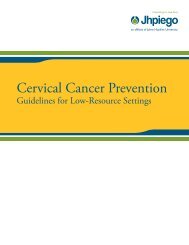Manual for Male Circumcision under Local Anaesthesia
Manual for Male Circumcision under Local Anaesthesia
Manual for Male Circumcision under Local Anaesthesia
Create successful ePaper yourself
Turn your PDF publications into a flip-book with our unique Google optimized e-Paper software.
<strong>Male</strong> circumcision <strong>under</strong> local anaesthesia<br />
Version 3.1 (Dec09)<br />
SURGICAL METHODS<br />
Three widely used methods of circumcision are described below. All<br />
three methods produce a good long-term result, but require different<br />
levels of skill. The sleeve method produces an excellent result, but<br />
requires the highest level of surgical skill. The <strong>for</strong>ceps-guided method<br />
produces a less tidy result initially, but has the advantage that it is a<br />
simple technique suitable <strong>for</strong> a clinic setting. In clinical trials it has<br />
been shown to produce consistently good results with low complication<br />
rates. It cannot be used <strong>for</strong> men with phimosis, since the <strong>for</strong>eskin<br />
cannot be fully retracted. The dorsal slit method is probably the most<br />
widely used method worldwide.<br />
At present, devices similar to those used <strong>for</strong> paediatric circumcision<br />
(see Chapter 6) are either not available or not suitable <strong>for</strong> adult<br />
circumcision. Evidence is needed from clinical trials be<strong>for</strong>e such<br />
devices can be recommended.<br />
Forceps-guided method of circumcision<br />
This is a simple step-by-step procedure, which can be learnt by<br />
surgeons and surgical assistants who are relatively new to surgery. It<br />
can be used in clinics with limited resources, and it can be done<br />
without an assistant. A disadvantage of the procedure is that it leaves<br />
between 0.5 and 1.0 cm of mucosal skin proximal to the corona. The<br />
<strong>for</strong>ceps-guided technique was used in the South African and Kenyan<br />
trials of circumcision and HIV infection. The version described here<br />
was standardized by the Kenyan study team.<br />
Step 1. Prepare skin, drape and administer anaesthesia, as described<br />
above.<br />
Step 2. Retract the <strong>for</strong>eskin and separate any adhesions, as described<br />
above.<br />
Step 3. Mark the intended line of the incision, as described above.<br />
Step 4. Grasp the <strong>for</strong>eskin at the 3 o’clock and 9 o’clock positions with<br />
two artery <strong>for</strong>ceps. Place these <strong>for</strong>ceps on the natural apex of the<br />
<strong>for</strong>eskin, in such a way as to put equal tension on the inside and<br />
outside surfaces of the <strong>for</strong>eskin. If this is not done correctly, there is a<br />
risk of leaving too much mucosal skin or of removing too much shaft<br />
skin.<br />
Step 5. Put sufficient tension on the <strong>for</strong>eskin to pull the previously<br />
made mark to just beyond the glans. Taking care not to catch the<br />
glans, apply a long straight <strong>for</strong>ceps across the <strong>for</strong>eskin, just proximal to<br />
the mark, with the long axis of the <strong>for</strong>ceps going from the 6 o’clock to<br />
the 12 o’clock position (taking the frenulum as the 6 o’clock position).<br />
Surgical procedures <strong>for</strong> adults and adolescents Chapter 5-17
















